Northwest control-line workshops
Where we build our planes
Before a control-line plane can be flown, it has to be built. Control-line modelers, being creative types to begin with, find all kinds of interesting ways to make space for the process of creating and storing airplanes. Our shops range from expansive multi-roomed, heated and air-conditioned basement or stand-alone outbuildings -- to a simple kitchen table from which the modeling stuff has to be removed before dinner.
In this Flying Lines feature, we ask Northwest CL modelers to send in pictures of your workshops, along with some brief notes about interesting features. It doesn't have to be all clean and neat -- we want to see how shops really work when they're in use. No shop is too fancy or too humble for inclusion here. Let's share some pictures and have some fun comparing our work spaces. Just e-mail your photo and information to the editor.
Robin Mason's shop building
 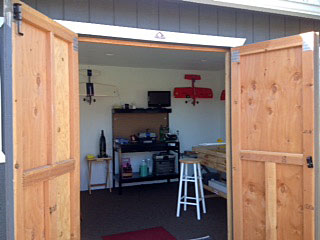
Robin Mason of Lebanon, Ore., built this free-standing shop in 2020. The building has room for workbenches and airplane storage. Robin Mason photos.
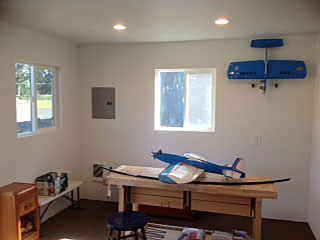 
 
Dave Shrum's spark-ignition engine display

In recent years, Dave Shrum of Roseburg, Ore., has concentrated his control-line modeling efforts on aircraft powered by vintage spark-ignition engines. This is some of his collection. Dave Shrum photo
Gene Pape's workshop

Gene Pape of Eugene, Ore., makes efficient use of a very small workshop space. His model airplane hobby shares space in a two-car garage with two cars and household appliances. Gene has turned one end of the garage into workbench and tool storage, and stored his 100 airplanes in clever spaces around the rest of the garage. The shop is Internet-connected, heated and well lighted. Above photo shows the main workbench, and other photos show airplane and tool storage. Gene Pape photos.
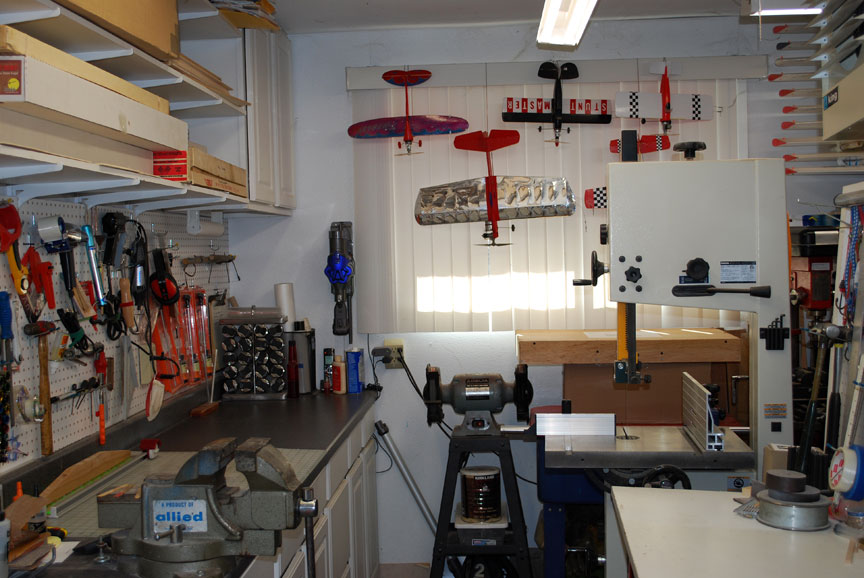 
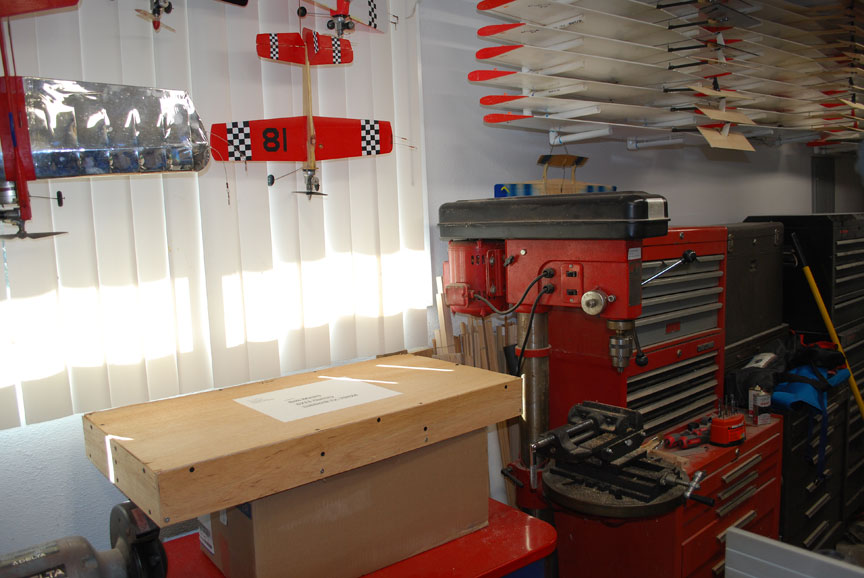 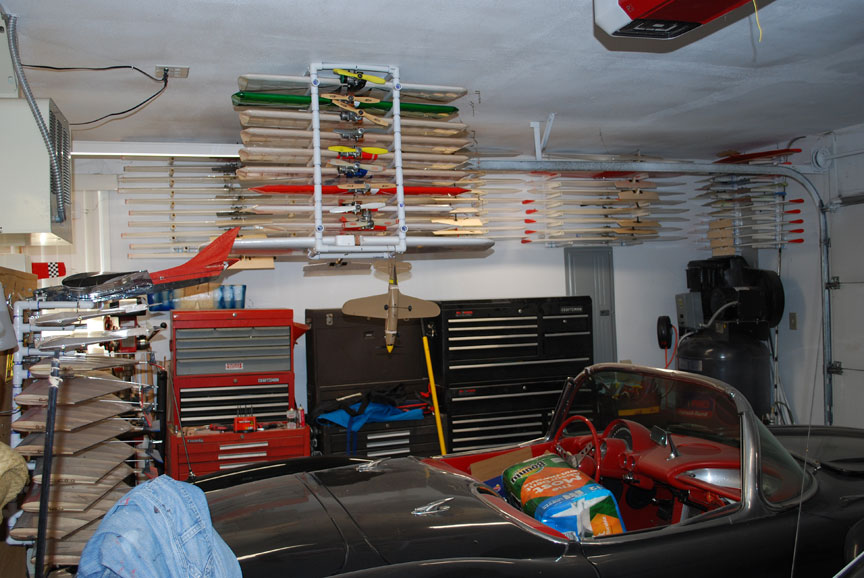
 
Mike Hazel's workshop
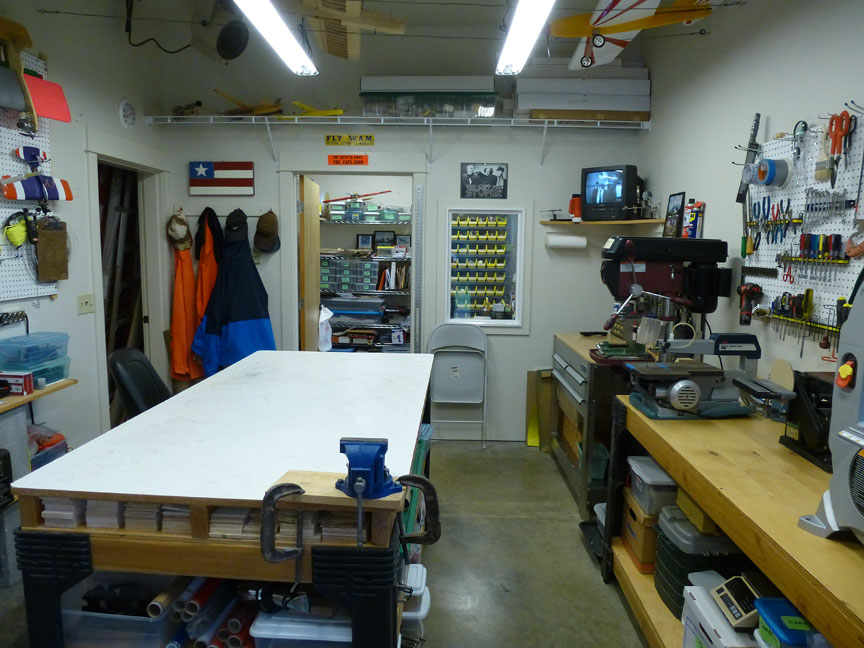 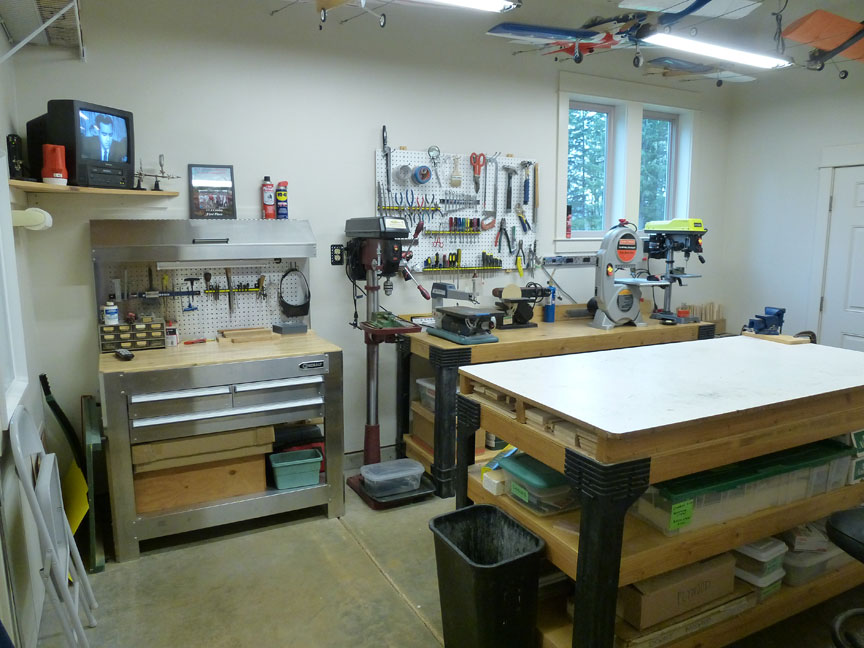
Mike Hazel explains: The Zoot workshop was planned ahead of time when we built our new house, which we moved into in 2013. The shop is essentially the third bay of a triple garage area, but completely walled off. The view on the left is coming in the door from the outside (a few yards away from the backyard flying circle). The white top bench in the middle has a couple of large shelves underneath for storage, including balsa storage immediately under the top deck. The shop is divided into two parts, the large section in the foreground and a smaller area towards the rear which functions as an office and more storage area. The view on the right is looking into the shop from the garage. The stainless steel workbench on the left is the designated metal working area. A small lathe is boxed up below, drawers hold lathe tools and various metal working bits. Bench to the right was custom built to fit the space and hosts power tools on the top, and storage below. A pegboard just above the bench holds necessary everyday type tools. Specialty tools and equipment are boxed and stored below. Most of the planes in the shop are stored up near the ceiling: Parallel plastic coated wires run from one side to the other and the plane wings just sit on them. The ten foot high ceiling allows the planes to be out of harm's way, but the downside is that a ladder is required to fetch them. The small TV up in the corner serves as distraction to efficient building.
 
The left view of the bottom pair of photos is looking into the office/storage room. Inside there is a small desk, file cabinets, plenty of shelving above the door, a large roll-around shelf unit, and a 96-bin storage unit. This room also has the HVAC system for the house tucked into one corner. The view on the right is looking out of the office/storage room. On the wall is a large pegboard system which primarily holds a collection of line reels and handles, along with some small planes and speed plane takeoff dollies. Right below that are some shelves that hold various flying field toolboxes, starters and batteries. In the corner is a metal cabinet that holds fuel, glue, paint, and engines. Right next to it is a genuine K&S metal center like the hobby shops all used to have. Plenty of electric outlets and power strips are around the room. Mike Hazel photos.
Randy Powell's workshop

Randy Powell of Port Orchard, Wash, has a well-organized workshop for producing his gorgeous stunt planes. There's a small workbench, a big building bench, and wall space for plans. Randy Powell photos.

Bill Heher's workshop
 
Bill Heher lives in Orlando, Fla., but is in Portland on business regularly and flies with the Northwest Fireballs at Delta Park. His newly completed shop includes a garage area for "dirty" work such as cutting and sanding (left), plus an indoor area for building, free-flight and micro planes, and engine work. He makes good use of closets for storage (below). Bill Heher photos.

Bruce Hunt's new workshop

Bruce Hunt has recently moved from Salem, Ore., to Lake Stevens, Wash. and downsized his workshop. Bruce turned his garage into a well-thought-out workspace after four months and many visits to craigslist, Goodwill, Lowe's, True Value, and Home Depot. Bruce Hunt photo.
Ken Burdick's Kamloops workshop

Puget Sound area Combat and Speed flier Ken Burdick, a regular contributor to Flying Lines, recently moved to Kamloops, B.C. This (above and below) is the workshop space he carved out of his new residence. Ken Burdick photos.

Bob Lewis' workshop

Bob Lewis of Roseburg, Ore., is a prolific builder and flier of sport/stunt type airplanes. All of the planes shown in shop above and below are hand-painted. Bob is at right in the photo above, with Pete Benning (left) and Bill Mix. Dave Shrum photos.

Dave Shrum's workshop

Dave Shrum of Roseburg, Ore., makes good use of a small space. First two photos show his work area, and the third is the "hangar." Dave Shrum photos.


Floyd Carter's workbench

This is a portion of Floyd Carrter's workbench in Eugene, Ore. His shop is a double-car garage, fully finished and carpeted. A Palmer Venus is shown getting a repaint job. Floyd Carter photo.
Rory Tennison's shops

Rory Tennison is a "snowbird" who lives in three places at different times of the year -- Coeur d'Alene, Idaho, Diamond Lake, Wash., and Sunlakes, Ariz. -- and he has model shops in all three places. Photos here show two of the shops. Above is the shop area in the garage in Sunlakes. Rory Tennison photos.

This is the storage area in Sunlakes.
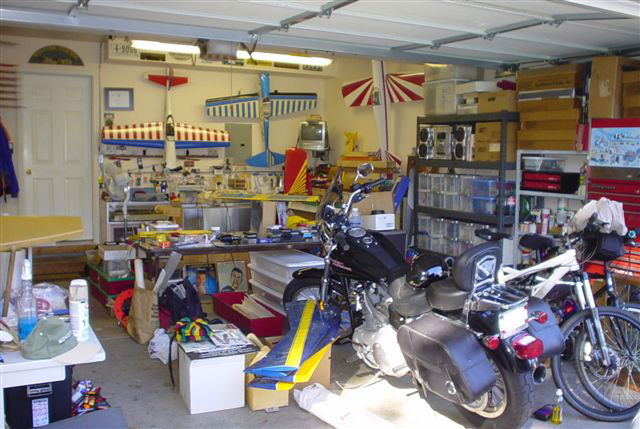
This is the garage/shop in Couer d'Alene.
The Flying Lines CL workshop

The FL editor's shop is crammed into about 1/3 of a two-car garage, taking up one auto bay. The garage door at right in the photo never opens. The shop features a 23-drawer workbench and in the foreground, a building bench with wallboard top. In this photo, the building bench is topped by a removable wing-building board, which is a glass sheet sandwiched between wallboard for perfect flatness. At left (out of the picture behind the magazine shelves and TV) are more shelves and an engine cabinet.

This is a view from "inside" the shop.

Models are stored hanging from their leadouts. At right are two wheeled clothes racks with planes (stunt/racing planes in foreground rack and combat planes in background, accessible from inside the shop area). At left are some additional planes hanging on an "overflow" cord. The shop is crammed and cluttered by necessity, but it functions! Would love to have about twice the space. Flying Lines photos.
This page was upated Feb. 22, 2021
|

